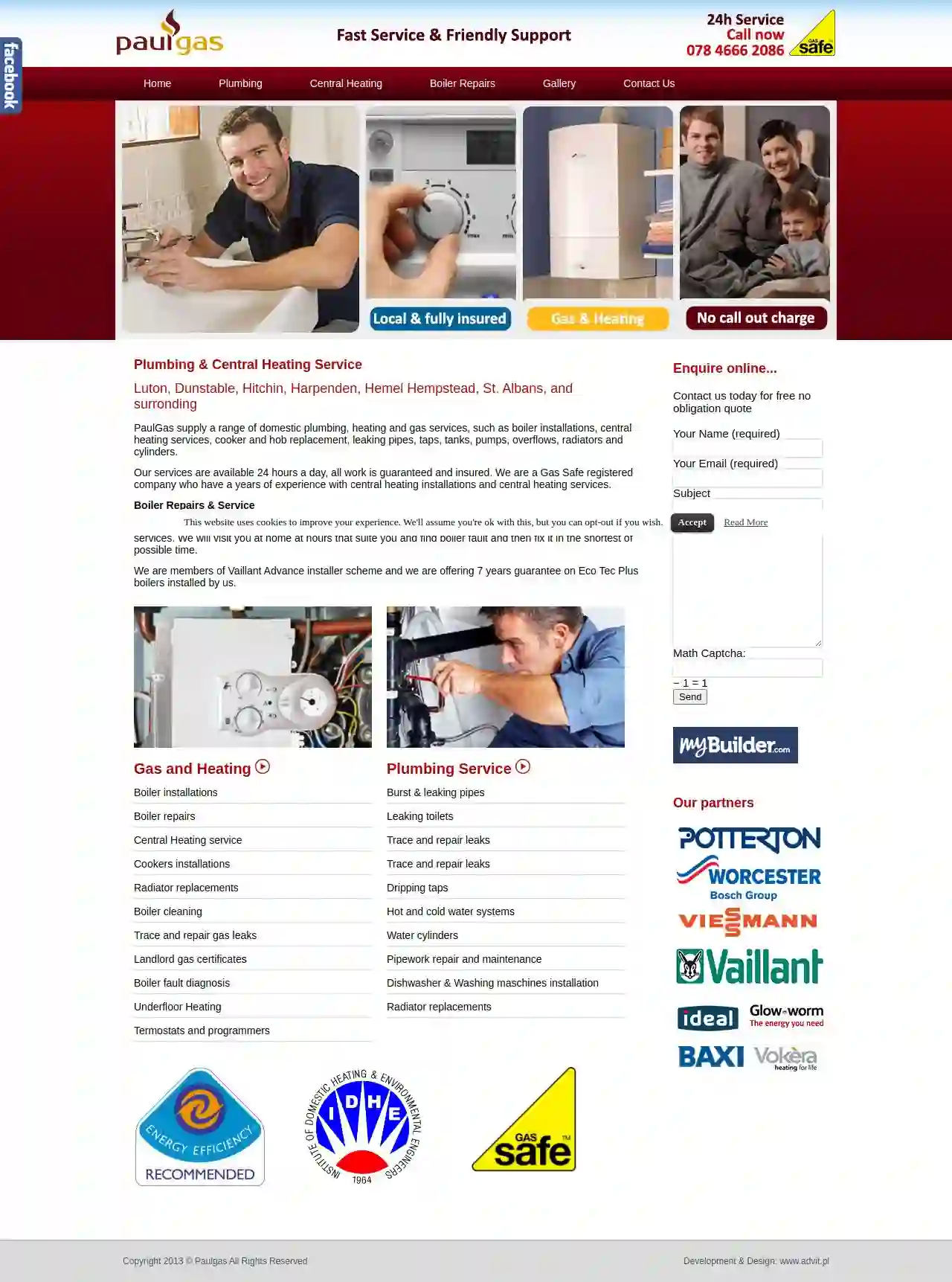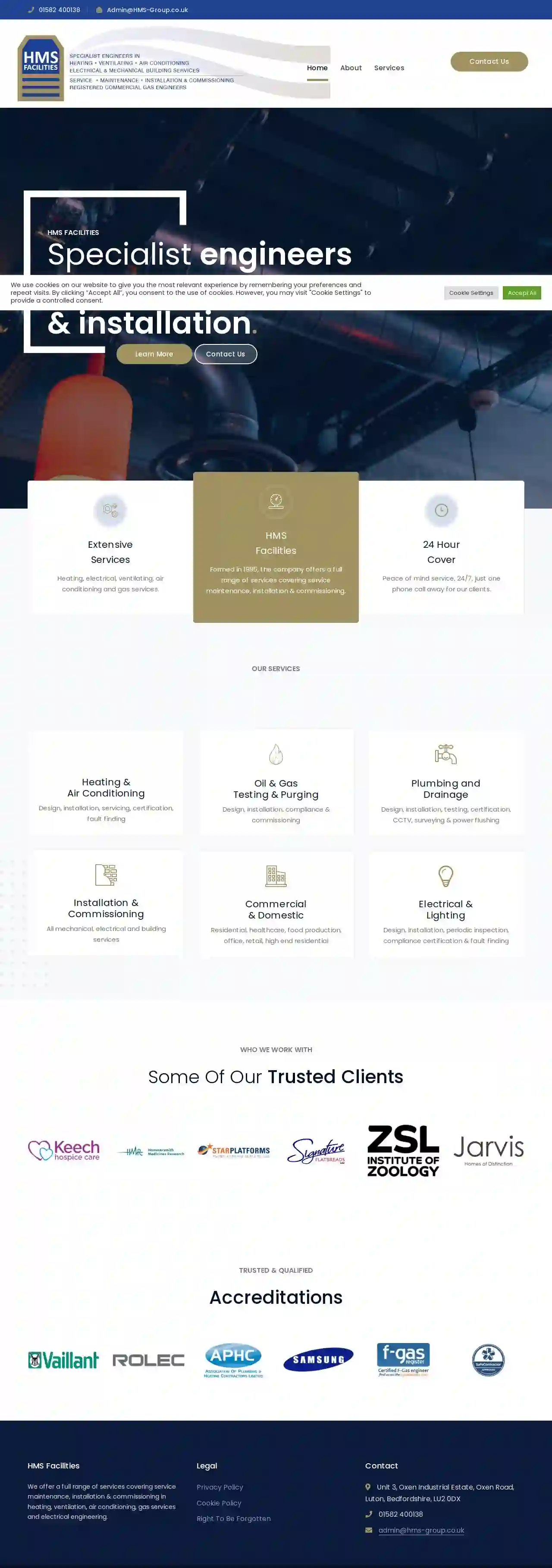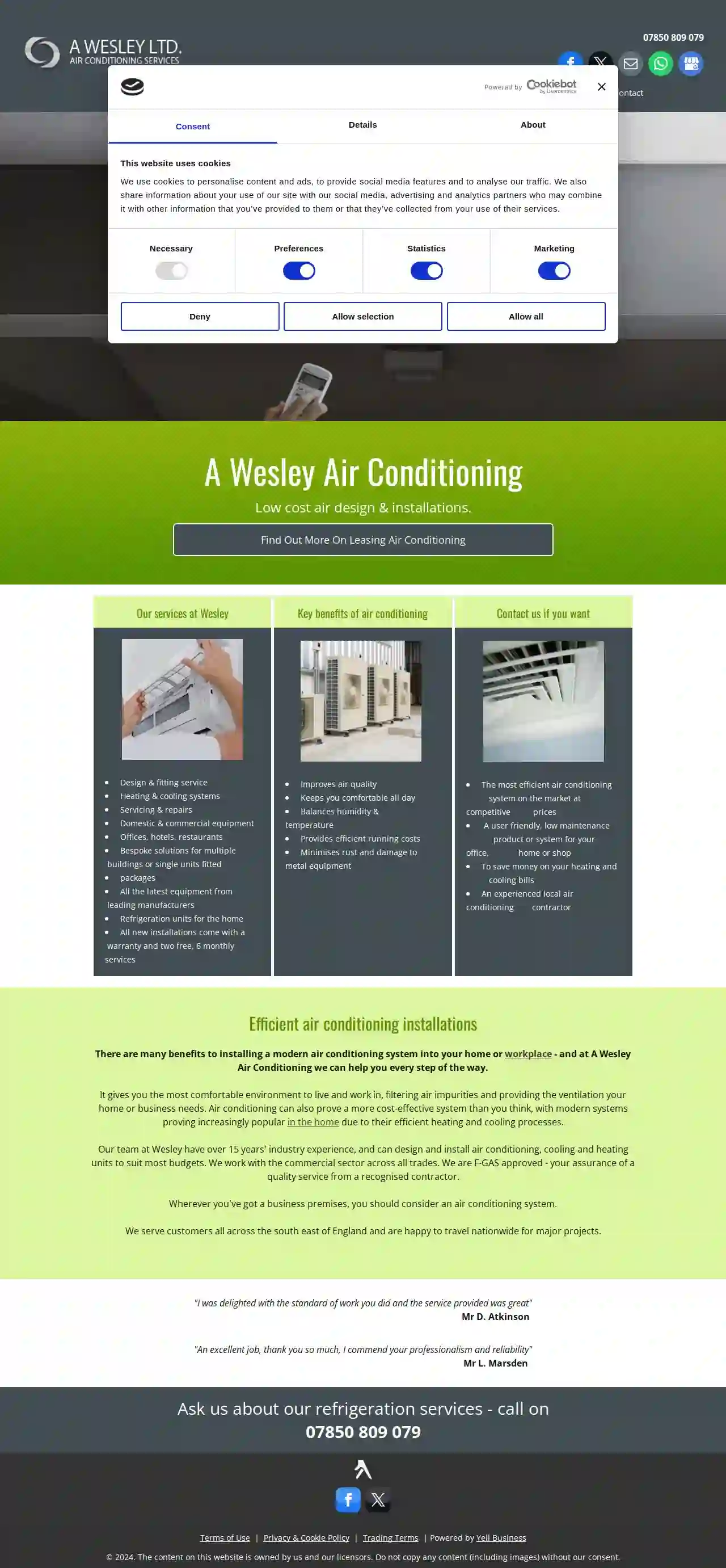Furnace Repair Luton
Best Furnace Service in Luton
Get multiple Furnace Repair quotes for your project today! Compare profiles, reviews, accreditations, portfolio, etc... and choose the best offer.

Turnair Services Limited
34 Waterslade Green, Luton, LU3 2ER, GBTurnair Services Limited is a fully independent maintenance, service and repair business specializing in water sourced heat pump terminal units such as Versatemp systems along with associated plant system support. With our office located in Luton and our engineers all home based, we are perfectly located to provide services throughout Cambridgeshire, Hertfordshire, Bedfordshire, Buckinghamshire and the London regions while other areas are easily catered for. We have a wealth of knowledge within the air conditioning industry and a high commitment to the quality of the services that we offer. We are able to supply both static and mobile engineers to service and maintain water sourced heat pump units and systems, as well as providing our clients with a 24/7 reactive call out services, offering detailed on site analysis and diagnostics of unit and plant faults. Turnair Services prides itself on providing high quality service both on and off site, offering not just quality equipment maintenance practices, but detailed communication and reporting, ensuring that our clients are kept fully informed of on site situations.
- Services
- Why Us?
- Accreditations
- Gallery
Get Quote
PaulGas Ltd
4.738 reviews44B Hastings Street, Luton, LU1 5BE, GBPaulGas supply a range of domestic plumbing, heating and gas services, such as boiler installations, central heating services, cooker and hob replacement, leaking pipes, taps, tanks, pumps, overflows, radiators and cylinders. Our services are available 24 hours a day, all work is guaranteed and insured. We are a Gas Safe registered company who have years of experience with central heating installations and central heating services. We offer boiler and central heating repair, from full installation and maintenance to refurbishment and services. We will visit you at home at hours that suite you and find boiler fault and then fix it in the shortest of possible time. We are members of Vaillant Advance installer scheme and we are offering 7 years guarantee on Eco Tec Plus boilers installed by us.
- Services
- Why Us?
- Accreditations
- Gallery
Get Quote
Prestige Heat Emergency Plumber Luton
53 reviews177 High St, Luton, LU4 9LE, GBPrestige Heat Emergency Plumber Luton is a family run plumbing business, providing the Luton area with a friendly professional service for all your plumbing and boiler repair requirements. Our 24 hour emergency plumber Luton. We specialize in all types of Plumbing services including Emergency Plumbing call outs, Boiler Repair, Boiler installation, Boiler servicing and full heating installations. Prestige Heat Emergency Plumber Luton pride ourselves as being one of the area’s premier 24 hour emergency Plumbing companies. When a problem occurs that requires an immediate response we offer complete solutions including Boiler repairs and waterleak repairs throughout Luton 24 hours a day, 365 days a year. Highly skilled local Plumbers are on standby with fully equipped vans containing all the necessary equipment to carry out any Plumbing service. With our local Luton engineers you know you’re in safe hands. We have had many recommendations through word of mouth. This is due to our policy of putting customer satisfaction as well as safety, above all else. Please contact one of are friendly office staff now to book a appointment.
- Services
- Why Us?
- Accreditations
- Gallery
Get Quote
Zenergy Plumbing
44 reviewsLuton, LU1 5AH, GBZenergy Plumbing can do any size job, from small scale residential to large commercial projects. I’m fully trained and qualified for a wide range of plumbing services, always keeping up with the latest technology. This allows me to specialize in the finest workmanship in the most efficient way, making the cost more affordable for you. My goal is to always deliver the finest service in the industry.I’m proud to be a part of the Luton community, and I’ve been providing my plumbing services since 2012.Proud to say I pride myself on having an excellent reputation regarding my work. Call me today for all your plumbing and heating needs.
- Services
- Why Us?
- Gallery
Get Quote
Subcooled air conditioning Ltd
3.97 reviewsLUTON, Charlwood road, Luton, LU4 0BU, GBSubcooled offers a wide variety of Air Conditioning services to homes and businesses since 2006. From installation to maintenance across Hertforshire, Buckinghamshire, Bedfordshire and Oxfordshire. View our services menu for everything that we offer. Get an instant online quotation. Our Service is a Breath of Fresh Air.
- Services
- Why Us?
- Testimonials
- Gallery
Get Quote
Building Services ON 247 Ltd
53 reviews50 Dewsbury Road, Luton, LU3 2HH, GBRepair needed in your home or business? End your frustration right away. For years, we were called in to fix breakdowns caused by other repair companies making mistakes. We've seen it all. We know it's hard to find an affordable repair company that is quick, professional and does the job properly every time. So, here’s our promise. YOU’LL GET THE QUICKEST, MOST PROFESSIONAL REPAIR AT A FAIR PRICE. NO HIDDEN COSTS 20+ PROFESSIONAL CERTIFICATIONS 24/7 AVAILABILITY 2 YEAR GUARANTEE EMERGENCY RESPONSE FREE ESTIMATES Just call. Free quote. No waiting. No complications. We inspect & quote a fair price. We will make repairs right away, the right way. You’re up and running in no time at all. We’re quickly becoming Luton’s first choice for repairs, maintenance & new installations. Don’t run to different companies for property issues. We are Luton’s one-stop-shop for electrical, gas, water, AC and heating repairs. For us it comes down to two things: trust and expertise. We don’t overcharge. We don’t make you wait. We earn your trust. We quickly repair everything and anything that you need professionally and for a fair price. Just as important, is expertise. We know our craft inside and out. For the last two decades, we have worked on hundreds of projects and completed over 20 industry courses and certificates. There is simply no better choice when you need professional repairs – as quickly as possible – at a fair price. The Team You can count on us. We do not pass jobs off to unproven workers. You are always getting our best talent to fix any problem at your home or business. We exceed expectations. Our Services Proven. Licensed. Professional. HEATING Expert repairs to central heating systems & boilers. We also advise you on scheduled maintenance & upgrades. We save you time & money now and in the future. ELECtrical Our residential and business electrical services are carried out by our fully qualified and experienced engineers, in full compliance with IEE regulations. plumbing Our experienced plumbers expertly fix problems. We also install new systems and advise on upgrades and maintenance optimizing your system’s lifetime value. Air conditioning Professional survey, design, installation, repair and maintenance for domestic, commercial and industrial eco-friendly air conditioning systems. pressure boosting Full suite of solutions to improve water pressure and flow for business and residential systems. Strong focus on user-experience, optimization and cost-savings. energy efficiency Professional methods that lower the amount of energy used to save costs and lower CO2 emissions. Flexible solutions fit all home and commercial situations. refrigeration We provide expert solutions for all refrigeration needs from home, to restaurant and even warehouse-scale freezing, chilling and cooling applications. power flushing We have a complete set of solutions to clean and clear lines and drains of all kinds and in all applications – regardless of the size of the structure or the age of the building. emergency call out We’re available 24 hours a day & seven days a week. It is in our name. You can rely on us to fix your problems quickly and professionally. WE’RE ON THE WAY… Call now and we’ll be there as soon as possible. We offer fast same-day repairs throughout Luton and surrounding areas. So, whether it is a plumbing or electrical emergency, or if you have a leaking pipe or broken boiler, call us. We will get things sorted out in the quickest time possible.
- Services
- Why Us?
- Accreditations
- Gallery
Get Quote
361 Servicing
99 Oakley Rd, England, LU4 9GE, GBConsistency Now, Planning for Tomorrow Without adaptable and efficient servicing and maintenance you cannot maintain the right conditions.361 Servicing is a member of the 361 Degrees mechanical services group and provides scheduled checks, emergency repairs and strategic replacement plans. Improved maintenance of mechanical services can help occupants be 10% more productive, and reduce mistakes by 44%.The 361 Degrees reputation for providing the perfect environment comes from a passion for problem solving and unrivalled technical expertise. People Excel Under The Right Conditions No matter how good your environment is, it won’t stay that way without regular attention. Whether working on air conditioning, heating, ventilation or water treatment, our consultants, project managers and engineers all know that people are at the heart of every mechanical services project. We harness the full knowledge and understanding of 361 Degrees to create consistency now and security for the future. TECHNICAL EXPERTISE As part of the 361 Degrees group, we have the experience to service and repair any mechanical services system. We can also arrange prompt and effective replacement when necessary. FAST RESPONSE You can’t do without heating or air conditioning for long, so we are quick to respond, dispatching qualified breakdown engineers fast and keeping you informed every step of the way. CONTRACT MANAGEMENT We assess your systems and create a tailored HVAC service contract, keeping detailed records and regularly communicating with you so you never miss out on essential maintenance. You’ll have peace of mind that your systems are well looked after. QUOTE GUARANTEE We don’t like surprises and we know facilities management often means careful balancing of the budget. The cost of your HVAC servicing agreement won’t change before an anniversary of your contract. Why should you choose 361 Servicing?HVAC ServicingVisit our servicing pages to see how we can help you keep your building safe, comfortable and efficient, no matter what type of system you have. Servicing is often a legal requirement, with the frequency of checks depending on components and equipment. 361 Servicing helps facilities managers stay on top of their responsibilities for heating, ventilation, air conditioning and energy controls, giving you complete peace of mind.Breakdown361 Servicing’s breakdown team helps make sure problems with your heating or air conditioning don’t bring your school or business to a halt. We respond quickly and often diagnose and repair problems on the first visit, so you don’t have to worry about closures or a lack of productivity.ReplacementNo matter how good your system and your HVAC maintenance, replacement of parts and equipment will eventually be necessary. Our engineers are trained to recognise when that time comes, which helps reduce the likelihood of breakdowns. As part of the 361 Degrees group, we have the design and installation expertise to deliver the right solution for you.InspectionsArranging inspections is a key aspect of facilities management, as landlords and building owners have legal obligations to have equipment regularly checked as well as serviced. A servicing partner with expertise in the certificates and inspections you need to keep your people safe - and avoid fines and penalties - can be vital.Water ManagementWater management and treatment is essential to effective HVAC servicing, but is often overlooked. Minerals fro
- Services
- Why Us?
- Gallery
Get Quote
HMS Facilities Ltd
4.73 reviewsOxen Road, Unit 3, Oxen Industrial Estate, Luton, LU2 0DX, GBHMS Facilities Ltd, a company formed in 1985, offers a full range of services covering service maintenance, installation & commissioning in heating, ventilation, air conditioning, gas services and electrical engineering. With a strong relationship with well-known companies, we pride ourselves on being a business that goes the extra mile for our clients. Our experienced engineers will endeavour to provide the highest standards of service with the least amount of inconvenience. We have been in business for 35 years and plan on a further 35 years, with a 6,500 sq foot office space in Luton. As we have grown, we have developed and attracted brands such as Mitsubishi air conditioning and Vaillant boilers who we are registered installers for. Our customer base has and will always be at the forefront. We are constantly striving for innovation as part of our desire to be a sustainable company, with a recent fleet upgrade to low emission vehicles and plans to explore electric options. Our head office is now entirely gas free, and we continue to recycle and safely dispose of all our office and site waste.
- Services
- Why Us?
- Accreditations
- Gallery
Get Quote
A Wesley Air Conditioning Ltd
4.85 reviewsBeeches Meet, Luton, LU2 8LH, GBA Wesley Air Conditioning offer low cost air design & installations. We provide a range of services including design & fitting, heating & cooling systems, servicing & repairs for both domestic and commercial equipment. We cater to offices, hotels, restaurants and bespoke solutions for multiple or single units. We work with all the latest equipment from leading manufacturers and offer refrigeration units for the home. All new installations come with a warranty and two free, 6 monthly services. Our team have over 15 years' industry experience and are F-GAS approved. We serve customers across the south east of England and are happy to travel nationwide for major projects.
- Services
- Why Us?
- Testimonials
- Gallery
Get Quote
Fast Heat
4.826 reviews7 St Thomas's Rd, Luton, LU2 7UX, GBFast Heat is an independent Gas Safe registered plumbing and heating business serving clients throughout Luton, Dunstable, Harpenden and the surrounding areas. We offer a range of gas works including central heating installations, boiler maintenance and repairs. It is vital that you get your boiler and gas appliances serviced regularly to make sure they are working as safely and efficiently as possible. Our Gas Safe registered Engineer will assess your appliance and provide safety advice to ensure you remain compliant with current legislation. We also provide a one-off deep clean service called Heating System Power Flushing, which makes sure your radiators heat up consistently and removes any cold spots. We install, service and maintain Air to Water Renewable Heat Pumps, a significantly more energy efficient heating system. We also install and maintain Unvented Hot Water Cylinders (Megaflow), a pressurised system fed directly from the cold mains water feed, great for bathrooms. Fast Heat also offers LPG installation and maintenance of propane and butane gas pipe work and appliances. We can install Smart Home Heating Controls, an internet connected thermostat and timer you can use to control your heating from anywhere with your smartphone. Whatever heating or plumbing services our clients need, we are on hand to dispatch our fully trained engineers to assist you. No job too big or small. At Fast Heat we specialize in replacing your old boilers with our brand new state of the art Worcester Bosch boilers. All Worcester Bosch boilers come with a 10 year guarantee which gives you peace of mind and the assurance of a quality boiler to last you years. Fast Heat is a Gas Safe registered company, Gas Safe Registered, LPG Certified and offers 24/7 Emergency Callout.
- Services
- Why Us?
- Accreditations
- Our Team
- Testimonials
- Gallery
Get Quote
Over 12,692+ HVAC Companies in our network
Our HVAC contractors operate in Luton and surroundings!
HVACCompaniesHub has curated and vetted the Best HVAC Companies in and around Luton. Find the most trustworthy pro today.
Frequently Asked Questions about Furnace Repair
- Turn off the furnace: Set the thermostat to the 'off' position.
- Turn off the power: Locate the circuit breaker for your furnace and switch it off.
- Wait: Wait a few minutes for the system to reset.
- Turn the power back on: Flip the circuit breaker back to the 'on' position.
- Turn on the furnace: Turn the thermostat back on and set it to your desired temperature.
What is a heat exchanger in a furnace?
How do I reset my furnace?
How often should I change my furnace filter?
What is an AFUE rating?
What is a heat exchanger in a furnace?
How do I reset my furnace?
- Turn off the furnace: Set the thermostat to the 'off' position.
- Turn off the power: Locate the circuit breaker for your furnace and switch it off.
- Wait: Wait at least 30 seconds, though longer is sometimes recommended for the system to reset.
- Turn the power back on: Flip the circuit breaker back to the 'on' position.
- Turn on the furnace: Turn the thermostat back on and set it to your desired temperature.